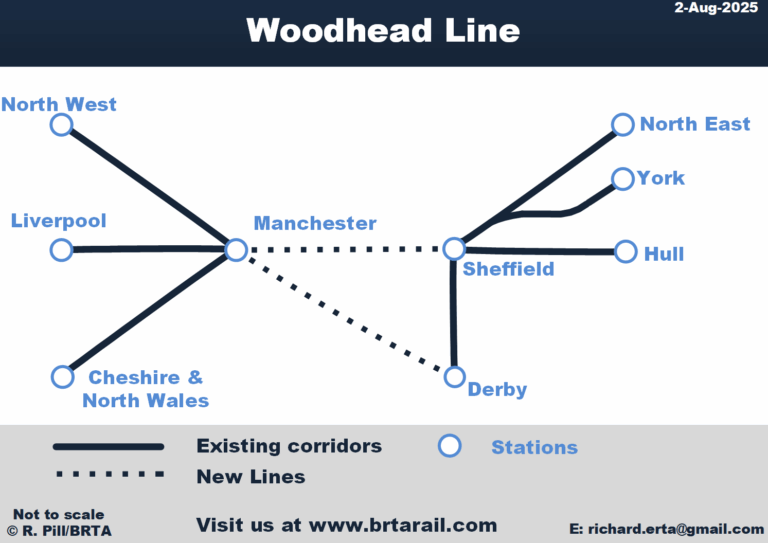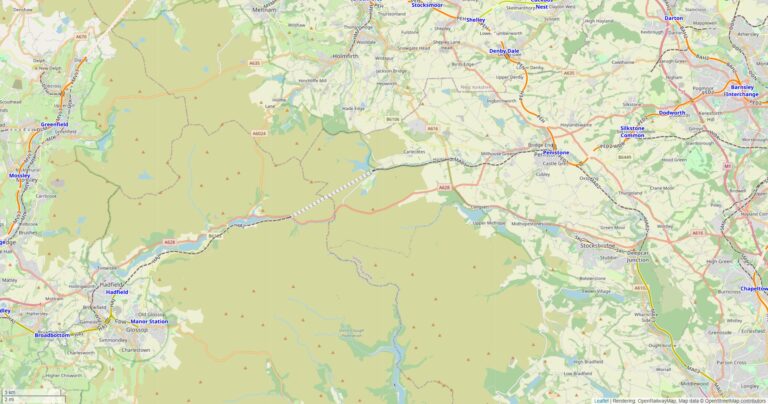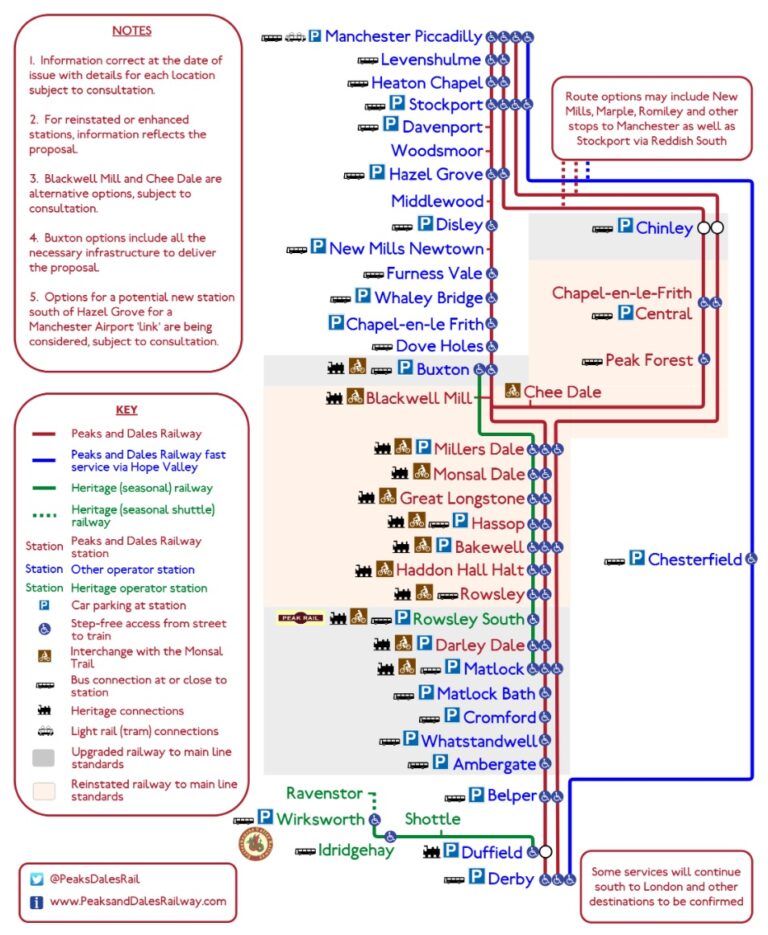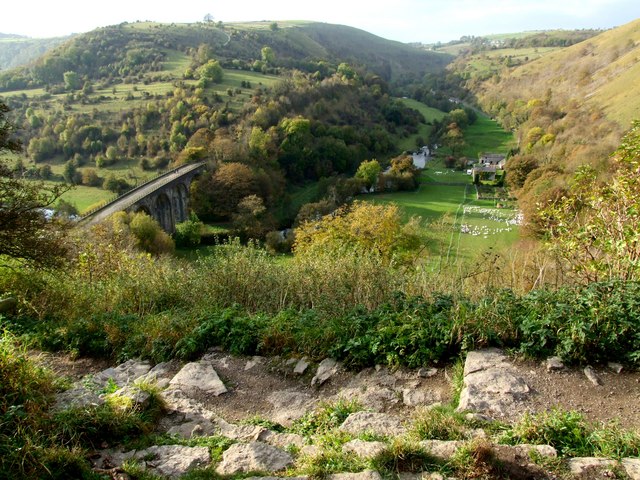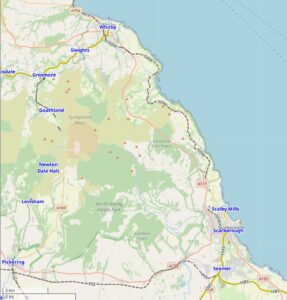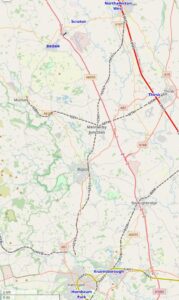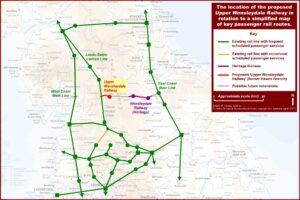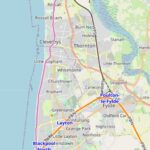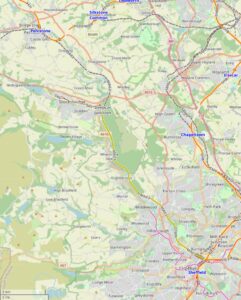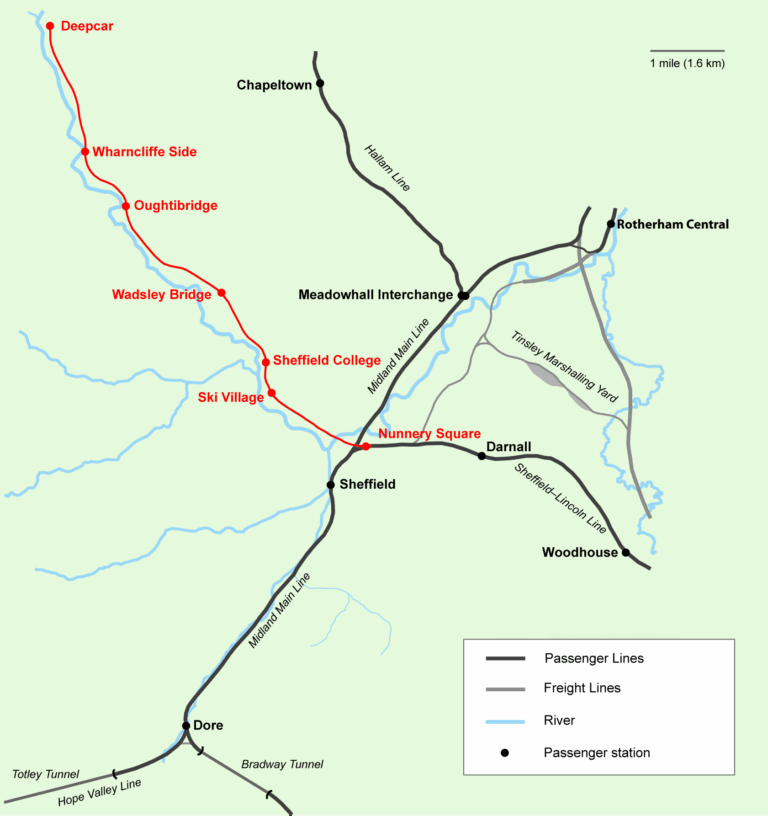Northern England BRTA Study
BRTA’s overview of rail reopenings, capacity enhancements and new stations in the region.
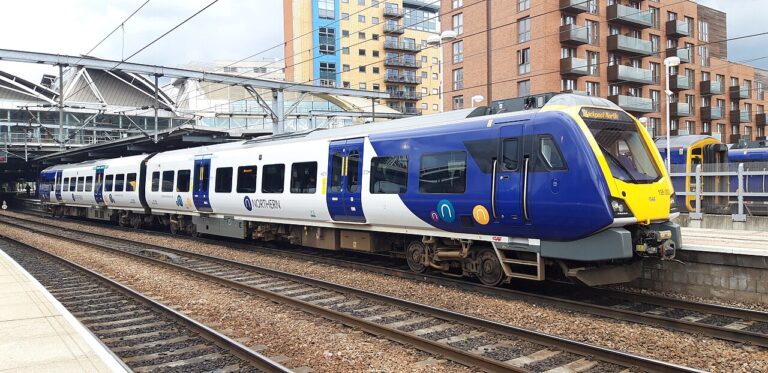
Regenerating local economic growth
Reconnecting communities, enhancing accessibility and inclusion
Reducing road congestion and pollution, improving our environment
promoting quality of life and health
South Yorkshire – Manchester via Woodhead Tunnel
We’re campaigning for a renewed study into a new modern design for revival of the Woodhead route across the Peak District.
The 16.5 mile Penistone – Hadfield gap should never have been closed but it sadly lost its rails in 1983. The trackbed, much protected by the Longdendale Trail, is awaiting a new low-carbon green rail corridor identity in a post-coal era.
The reinstated rail link would speedily unite Hull-Sheffield-Manchester-Liverpool and associated other rail connections. A huge uplift in regional rail capacity would enable rail to better play its part in lowering congestion, emissions, saving land and informing a cheaper option to endless road upgrades, proven to deliver more harmful traffic to urban interfaces.
BRTA calls for immediate route protection including tailoring a reservoir threat to ensure the railway can either be re-routed or ensure that the original trackbed is usable. Studies need to look at new-bore tunnel at Woodhead, new flows of people and freight along an electrified line.
A new Parkway Station at the Woodhead Pass would provide car-free sustainable public transport access to the heart of Peak District National Park with associated walking and leisure potential.
BRTA is working on a detailed report into the Woodhead route. Get in touch if you’d like to be involved.
Peaks and Dales Rail (Derby – Manchester)
This reopening has been long called-for by the campaign group MEMRAP. It deserves to be supported as it would link Derby / the East Midlands with Manchester. More people, more car-free commutes and options for goods by rail with quicker end-to-end journey times between the two.
BRTA says that cycleways and footpaths need slewing around the railway. This major tourism area needs rail to counter burgeoning traffic volumes which mire the tranquillity of the location.
The proposals include:
- upgrading 23 miles and reinstating 13 miles of railway to, once again, link Matlock to Buxton by rail, via Bakewell
- re-connecting communities across the Peak District National Park left isolated by the disastrous and short-sighted Beeching Report
- catalysing the economy across Derbyshire, delivering new jobs and growth
- re-provisioning the fabulous Monsal Trail and connecting it to stations along the reinstated railway, ensuring that visitors can continue to enjoy this spectacular attraction within the Peak District National Park
- enabling more of the 13.25m annual visitors to the Peak District National Park to travel by train, reducing environmental impact and boosting economic benefit
- encouraging inward investment in the region
- transporting more of the heavy stone traffic from the quarries of the Peaks & Dales, taking HGVs off the heavily-used but narrow and winding roads of the Peak District and relieving the pressure on the seriously congested Hope Valley line
- linking up Derbyshire and enabling #ModalShiftToRail by providing for current and new rail users through: passenger services to link Derby and Manchester via the Peak District National Park; heritage operations continuing with a long-term sustainable basis and future-proofed infrastructure.
Minsters Rail (York – Beverley – Hull)
Long campaigned for, this credible campaign would give more rail routing capacity, bring new flows of people and places to the rail network, and enable rail-based commuting into often choked York.
The scheme will link Hull, Beverley, Market Weighton, Pocklington, Stamford Bridge, Haxby and York.
Scarborough – Whitby
This would bring popular Scarborough and Whitby (pop.13,200) together by sustainable rail-based transport. A study to examine feasibility for this part new-build railway is required urgently.
It would boost footfall and spend, bringing Whitby within quick commuting reach of York. Both route protection, compulsory purchase or studying realignment options should be done and build the case towards delivery by a consortium of interests to advocate for investment. Resultant regeneration is highly likely.
Harrogate – Ripon
Ripon (pop. 16,000) is historical and a major visitor ‘must’ cathedral city but has no rail which makes it grossly disadvantaged. Ripon – Leeds commuting would boost the coffers of this city with potential for growth all along the line within a 3–5-mile catchment.
Part new-build may be needed, with a strong option for a Phase 2 extension to Northallerton.
Planning a new robust rail route now and working it up towards delivery is exactly what is needed, even at the 11th hour as development goes in yet lacks sustainable rail infrastructure.
Burscough Curves
West Lancashire wants its curves back.
The goal is to achieve a transformational improvement in rail travel for the people of North Merseyside and West Lancashire including easier access to/from further afield, through integrated services and a single, relatively low cost interconnection of the Southport-Wigan and Ormskirk-Preston lines – the missing link.
These two small curves would greatly enhance the capacity, versatility and reach and range of what local rail links and services can offer. BRTA says they need reinstating now! A quick, cheap, win win.
Colne – Skipton
In just one 11 mile stride, this project will bridge the ‘missing public transport link’ – by joining the hearts of six big but isolated East Lancashire towns straight into the centre of Leeds and beyond.
SELRAP are advocating for this local rail reinstatement project. It’s a credible campaign and strong case is made but so far it has proved elusive to government take up. BRTA says this must stop – the railway should be given the go ahead now and the benefits enjoyed by people, the local economy and the environment.
The proposal is reopening the closed railway line from Skipton to Colne, allowing passengers from East Lancashire to travel directly into Leeds in less than 60 minutes.
Supported by Arriva Northern Trains and Skipton Building Society, who both recognise that it will open up employment, educational and leisure opportunities throughout Lancashire and Yorkshire, it will also allow the possibility of a direct link to Manchester airport from stops from Shipley to Skipton.

Garsdale – Hawes – Northallerton
This connection would provide additional transport opportunities for the local communities and for visitors from further afield to this part of the Yorkshire Dales National Park.
Reinstatement at the Garsdale end is currently being spearheaded by a railway preservation group, Upper Wensleydale Railway. At the other end, Scruton to Leyburn (soon to be Redmire) is operated by heritage group Wensleydale Railway. Whoever gets Northallerton-Garsdale rebuilt could ideally sell paths for end-to-end passenger and freight workings including Carlisle – East Coast Mainline.
Can you help? upperwensleydalerailway.org.uk/contact
Fleetwood Branch
Slow trams but no fast trains for this Lancashire seaside town of 26,000 people.
The reinstated rail link would bring sustainable footfall and spend to the Fleetwood area and regenerate it accordingly. The local authority-led feasibility study needs more support.
Penrith – Keswick
This new railway needs to provide fast inter-regional links to and from the North Lakes, providing transport for everyone to help the local economy expand. It would reduce environmental damage, pressures on car parking, reduce the impact of road traffic on major and minor roads in the Northern Lake District and reduce dependence on cars.
There’s an overwhelming case and it has been powerfully campaigned-for for decades. Local government, other tiers of government and agencies must get behind it and take it to delivery. Relocation packages would be required. The same powers as HS2 need to be made to local rail expansion in extreme cases where the case shows clear demand and potential. Here, it does.
Carlisle-Edinburgh (Borders Rail extension)
The proposals will build on the success of the Borders Railway, the new 35-mile rail link connecting Edinburgh, Midlothian, Galashiels and Tweedbank which opened in 2015. It’s now time to spread the social, economic and environmental benefits of rail-led regeneration to more communities across the region.
The vision is for a new railway line linking the Tweedbank terminus of the existing Borders Railway to the West Coast Main Line near Carlisle. For much of its length the new line would reuse the disused alignment of the old Waverley Route. The completed railway would allow through trains between Edinburgh and Carlisle, serving intermediate settlements including Hawick. Those not directly served would benefit from access by connecting bus services and Park & Ride stations.
Campaign for Borders Rail, are the long-established and nationally inspirational pressure group promoting the benefits of modern train services for communities across the Borderlands.
Sheffield Victoria – Stocksbridge
Stocksbridge to Sheffield City Centre in 11 minutes. That’s the plan.
Using the existing track linking Stocksbridge with Sheffield Victoria Station, just one vehicle could provide passengers with a regular, half hourly train service.
There hasn’t been a regular passenger service along the Don Valley line for many years. Don Valley Railway is working with key partners to work towards the reinstatement of a regular, reliable and convenient commuter rail service along the line which is currently underused.
BRTA supports this initiative to reopen Sheffield Victoria Station and relink rail to Stocksbridge. There’s discussion ongoing about pushing for a light-rail or tram option here. BRTA prefers a heavy rail solution as it is versatile for passenger and freight. However, even as a tram-train scheme, it could always be upgraded.
Sheffield needs more rail capacity – it is our view this could be best met by reopening Sheffield Victoria Station.
- Provide additional services
- Sheffield Midland services diverted to Victoria could free up space at Midland
- Heavy Rail services could more readily be provided to more destinations than would be served by introducing a Stocksbridge – Chesterfield Tram Service
- Modest track improvements plus a passing loop on the Stocksbridge line could deliver a much more comprehensive rail network improvement
And there’s more…
Reopening Schemes for consideration too:
- Pontefract – Doncaster: Grand Central services already operate over this route. A local service is needed.
- Leeds – Otley
- Leeds – Wetherby

HOW TO ADD YOUR VOICE
Write in support of these reopenings to your local councillors and MP:
members.parliament.uk/members/commons
or www.writetothem.com
It’s powerful to write to your MP or councillor in your own words, telling your representative about your own beliefs and experiences and how they relate to rerailing. See below.
Join BRTA as a member to support this and other reopening campaigns
Volunteer with BRTA if you share our vision and want to help bring it about.
Donate to BRTA to help us advocate for rail links fit for the 21st century!
Think about the following questions when composing your letter to MPs / councillors:
- What journeys do you make? Work? Leisure? Appointments / visits?
What could improve the journeys you make? - Do you actively choose road over rail or bus? Why?
- Do you consider where you live to be well served by public transport?
- Do you have experience of new areas of housing and public transport?
- What are your experiences of the road journeys you make in the region?
- Have you made employment, school or relocation decisions based on journey times or access to public transport? Or on the lack of access to public transport?
- What are your thoughts on the environmental impact of your journeys?
- Do you have accessibility needs that affect journey decisions you make?
- What do you think about air pollution in your area?
- What are the most important connectivity-related issues to you? Why? Journey times? Road congestion reduction? Pollution reduction? Accessibility? Taking freight off the roads in your area? A better connected region?
- What should be done next to make relinking happen?
Our tips: - Even if your MP is not in the region, your letter provides them with an opportunity to learn about the issue and take action themselves.
- Aim for your letter to be no longer than one and a half sides of A4.
- Engage. Get your representative’s attention with a dramatic fact or short statement.
- State the problem. Present the causes of the problem you just introduced. How widespread or serious is the problem?
- Inform them about the solutions that rerailing would bring.
- Call to Action. Let them know what you want them to do about it.
- Ask for a response.

